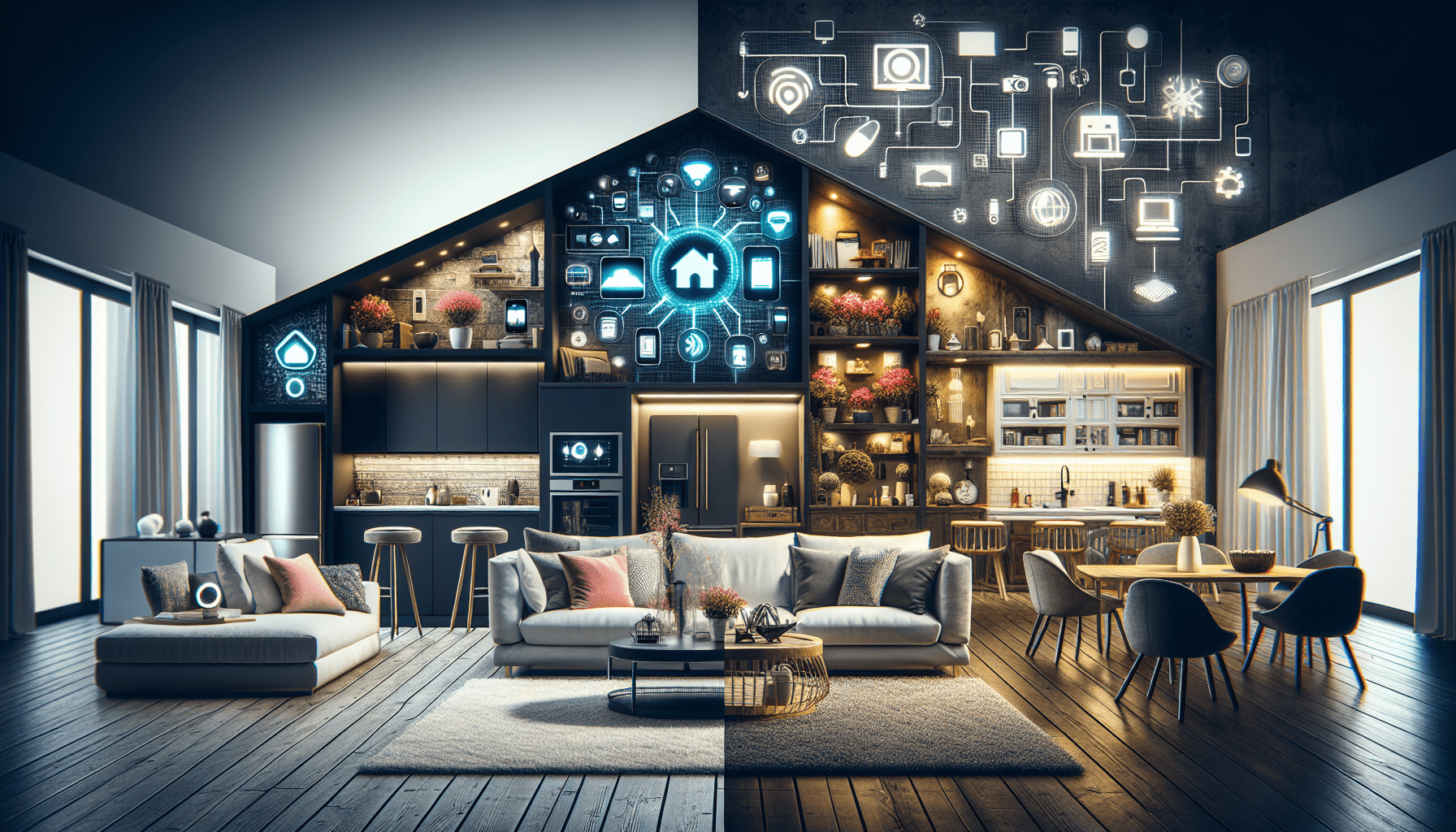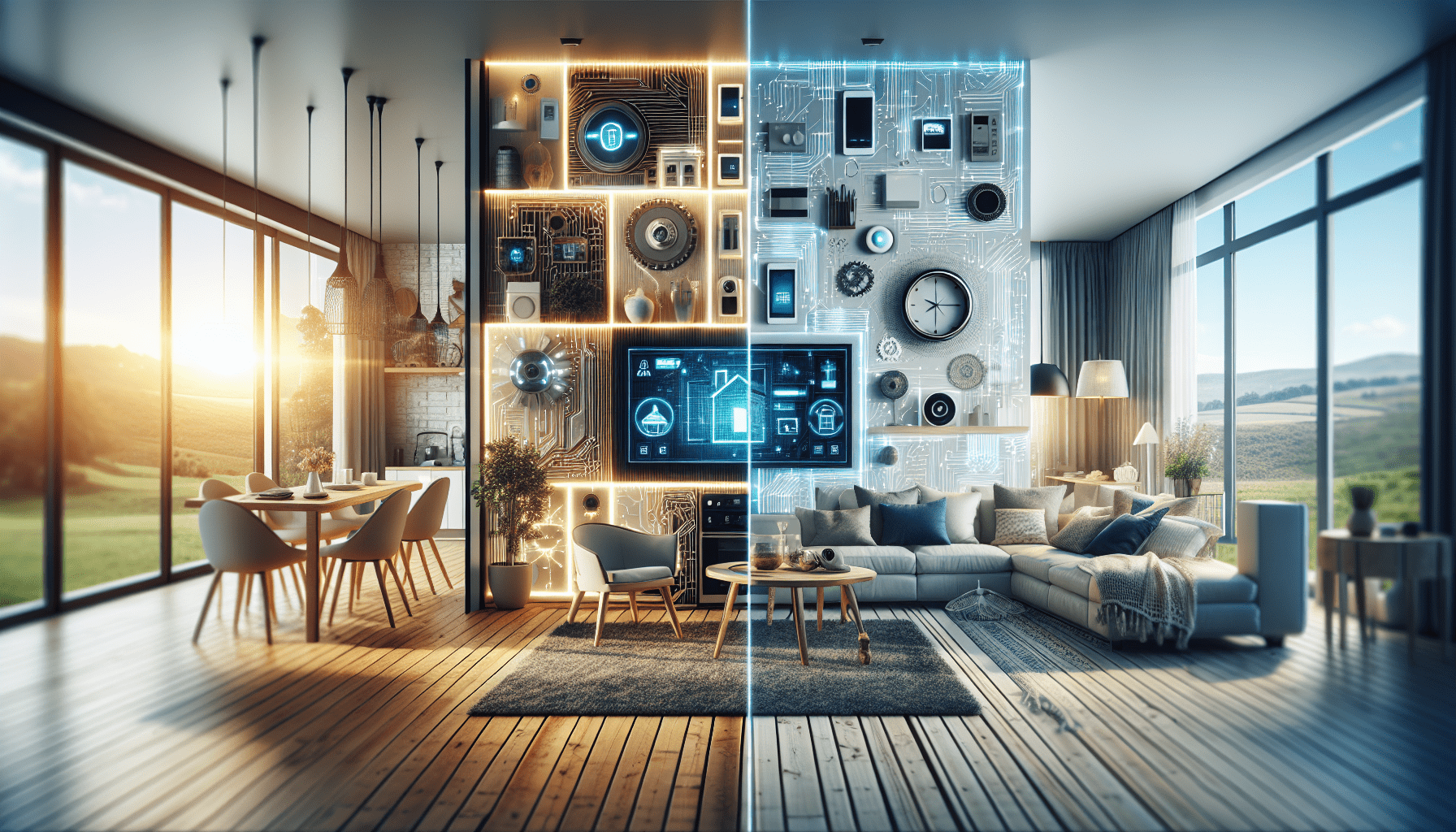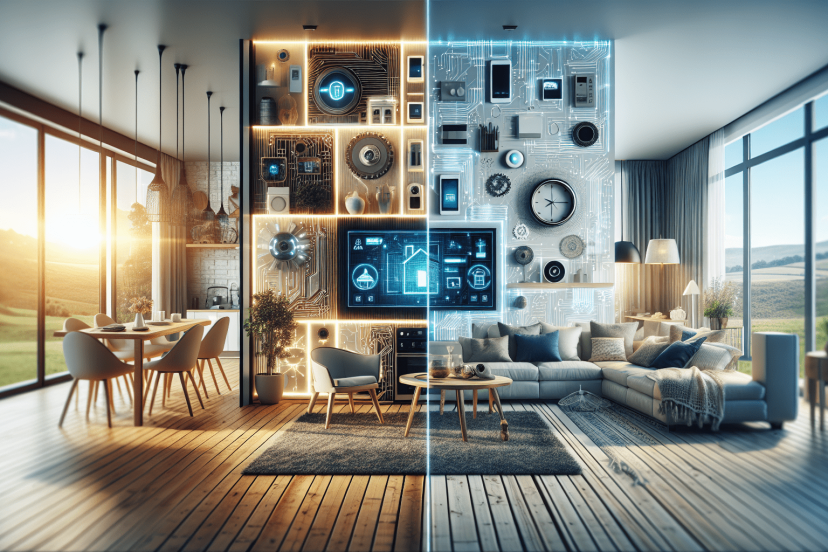What Is The Difference Between A Smart Home And A Normal Home?
Imagine waking up in the morning and as you stumble out of your bedroom, the lights automatically turn on and the blinds gradually open to invite the soft sunlight into your home. As you make your way to the kitchen, the aroma of freshly brewed coffee wafts through the air, thanks to your smart coffee maker that started brewing the moment your alarm went off. This is just a glimpse into the world of a smart home, where everyday tasks are simplified and automated to create a more convenient and efficient living environment. In contrast, a normal home relies on manual operation and traditional appliances to complete these same tasks. Curious to know more about the difference between a smart home and a normal home? Read on to discover the fascinating ways in which technology can transform your home into a futuristic haven.

Definition of a Smart Home
A smart home is a residence that incorporates advanced technologies to enhance the functionality, convenience, and efficiency of various household systems. It harnesses the power of automation and connectivity to offer a seamless and integrated living experience. By integrating technology into the various aspects of the home, such as lighting, heating, security, and entertainment systems, a smart home provides unique benefits that redefine modern living.
Integration of Technology
At the core of a smart home is the integration of technology. Smart devices, sensors, and appliances are seamlessly interconnected to create a unified ecosystem. This integration allows for efficient communication and coordination between different systems in the house. From voice-controlled virtual assistants to smart thermostats, these technologies work together to provide an unprecedented level of control and convenience.
Automated Control Systems
One of the defining features of a smart home is the presence of automated control systems. These systems enable homeowners to remotely control and automate various functions within their homes. For example, you can effortlessly adjust the temperature, turn on/off lights, or even start your washing machine through a mobile app or voice command. This automation not only saves time and effort but also enhances energy efficiency and overall comfort.
Definition of a Normal Home
In contrast to a smart home, a normal home refers to a traditional residence that relies on manual operation and lacks advanced technological features. These homes are typically constructed using traditional construction materials and designs. While they provide a comfortable living space, they lack the level of convenience, efficiency, and connectivity offered by smart homes.
Traditional Construction and Design
Normal homes adhere to conventional methods of construction and design. They are built using standard materials such as bricks, wood, and concrete, and often follow the architectural styles prevalent in the area. While these homes may be aesthetically pleasing, they lack the integration of technology and innovative design elements found in smart homes.
No Automated Systems
In a normal home, everyday tasks and functions are typically performed manually. You need to physically adjust the thermostat, flip light switches, and manually control appliances. Unlike a smart home, there are no automated systems in place to simplify and streamline these processes. This manual control can be time-consuming and may result in higher energy consumption.
Connectivity and Communication
The connectivity and communication capabilities of a home play a significant role in determining its smartness. The ability to connect to the internet and facilitate communication between devices is a key feature of a smart home, setting it apart from a normal home.
Smart Home: Internet-of-Things (IoT)
Smart homes are part of the Internet-of-Things (IoT) ecosystem, where devices, sensors, and systems communicate with each other over the internet. This interconnectedness enables seamless communication and coordination between devices, allowing you to control and monitor different aspects of your home remotely. Whether it’s adjusting the temperature while you’re away or receiving real-time notifications about security events, the power of IoT integration makes a smart home truly connected.
Normal Home: Limited Connectivity
In a normal home, the level of connectivity is limited compared to a smart home. While you may have access to the internet for general purposes, the absence of IoT devices and advanced connectivity features means that communication between different systems within the home is limited. This lack of connectivity restricts remote control and monitoring capabilities and prevents the integration of various devices and technologies.

Remote Control and Monitoring
The ability to control and monitor your home from anywhere is a significant advantage offered by smart homes. This remote control functionality enhances convenience, security, and energy efficiency, making it a desirable feature for modern homeowners.
Smart Home: Ability to Control Remotely
With a smart home, you have the power to control and monitor various systems remotely. Through dedicated mobile apps or voice assistants, you can adjust the thermostat, lock/unlock doors, turn on/off lights, and even view security camera footage, all from the palm of your hand. This remote control capability offers unparalleled convenience, especially when you’re away from home or unable to physically interact with the systems.
Normal Home: Manual Control Only
In a normal home, you are limited to manual control only. Adjusting the temperature, turning on lights, or checking security cameras can only be done when you are physically present in the house. This reliance on manual control not only limits convenience but also hinders the ability to monitor and manage your home efficiently.
Energy Efficiency
Smart homes excel in energy efficiency due to the integration of advanced technologies and automated energy management features. This focus on energy conservation not only helps to reduce utility bills but also contributes to a more sustainable and eco-friendly lifestyle.
Smart Home: Energy Management Features
Smart homes are equipped with energy management features that optimize energy usage. For instance, smart thermostats can learn your preferences and adjust temperature settings accordingly, ensuring efficient heating or cooling. Additionally, smart lighting systems can automatically adjust brightness based on occupancy, reducing unnecessary energy consumption. These energy management features enable smart homes to operate in a highly efficient manner, minimizing waste and environmental impact.
Normal Home: Traditional Energy Usage
Normal homes typically rely on traditional energy usage patterns with no advanced energy management features. Temperature control is manual, and lighting systems may not have occupancy sensors or dimming capabilities. As a result, energy consumption is often higher and less optimized in comparison to smart homes. The lack of automation and energy-efficient technologies limits the potential for reducing energy waste and lowering utility costs.
Security and Safety
When it comes to security and safety, smart homes offer advanced systems and features that provide enhanced protection and peace of mind. The integration of intelligent security technologies ensures comprehensive monitoring and effective response to potential threats.
Smart Home: Advanced Security Systems
Smart homes are equipped with advanced security systems that go beyond the basic measures found in normal homes. These include smart locks, motion sensors, surveillance cameras, and door/window sensors, all connected through a central hub. These interconnected security devices can detect suspicious activities and immediately notify homeowners through their smartphones, allowing for real-time monitoring and quick response. Additionally, smart homes offer the ability to remotely lock/unlock doors and arm/disarm security systems, providing an added layer of convenience and control.
Normal Home: Basic Security Measures
Normal homes typically rely on basic security measures such as traditional locks and alarms. While these measures provide a baseline level of security, they lack the advanced features found in smart homes. Monitoring is often limited to manual checks and traditional alarm systems, which may not provide immediate notifications or remote control capabilities. This limited security functionality may leave homeowners feeling less secure and more vulnerable to potential threats.
Customization and Personalization
A smart home offers a high degree of customization and personalization, allowing residents to tailor various aspects of their living environment to their preferences. From lighting scenes to personalized temperature settings, customization options in a smart home enable a unique and personalized living experience.
Smart Home: Tailored Settings for Residents
In a smart home, residents have the ability to customize various settings according to their preferences. Lighting scenes can be programmed to create specific moods or enhance productivity. Temperature settings can be adjusted based on individual comfort levels. With the integration of user profiles, smart homes can even adapt to individual preferences automatically. This high level of customization ensures that residents can create a living environment that suits their specific needs and preferences.
Normal Home: Limited Customization
In a normal home, customization options are limited. Lighting and temperature settings are typically manual, offering limited flexibility for personalization. Unlike a smart home, there is no automated adaptation or real-time customization based on individual preferences. This lack of customization options may result in a less personalized living experience, which may not cater to the unique needs and preferences of the residents.
Integration and Compatibility
The seamless integration of devices and technologies is a key feature of a smart home. This integration allows for efficient communication and coordination between different systems, enabling a unified and cohesive living experience.
Smart Home: Seamless Integration of Devices
Smart homes excel in their ability to integrate various devices and technologies into a unified ecosystem. Whether it’s syncing smart lights with entertainment systems, integrating security cameras with motion sensors, or connecting voice assistants to multiple devices, smart homes ensure seamless communication and coordination between different elements. This integration creates a cohesive and interconnected living environment that enhances convenience and efficiency.
Normal Home: Limited Device Compatibility
In a normal home, the level of device compatibility and integration is limited. The use of different devices and technologies may lead to compatibility issues, making it challenging to create a cohesive and well-integrated living environment. This lack of integration can result in a fragmented user experience and may hinder the overall functionality and convenience of the home.
Cost and Affordability
The cost of setting up a smart home versus a normal home is an important consideration for homeowners. While smart homes may require higher upfront costs, they offer long-term benefits that can outweigh the initial investment.
Smart Home: Higher Upfront Costs
Setting up a smart home involves investing in various devices, technologies, and installation services, which can incur higher upfront costs compared to a normal home. The cost of smart devices such as smart thermostats, security systems, and voice assistants must be taken into account. Additionally, installation and setup may require professional assistance. However, it’s important to note that the upfront costs are often justified by the long-term benefits and savings in energy consumption and improved efficiency.
Normal Home: Lower Upfront Costs
Normal homes generally have lower upfront costs as they rely on traditional construction materials and lack advanced technological features. The basic construction, appliances, and manual control systems tend to be less expensive compared to their smart counterparts. However, it’s essential to consider the potential long-term costs of higher energy consumption and limited efficiency associated with a normal home.
Future Potential and Expansion
The future potential and expansion capabilities of a home are key considerations, especially as technology continues to evolve and advance. Smart homes offer greater scalability and adaptability compared to normal homes.
Smart Home: Scalability and Adaptability
Smart homes are designed to be scalable and adaptable, capable of accommodating new technologies and devices as they emerge in the market. The integration of IoT devices and the use of hubs or platforms allow homeowners to easily incorporate new smart technologies and expand the functionality of their homes. This scalability ensures that a smart home can keep up with advancements and remain at the forefront of technology.
Normal Home: Limited Future Options
Normal homes, particularly those lacking advanced technological features, have limited future options for expansion and integration of new technologies. Upgrading or incorporating new technologies into a normal home can be challenging and may require significant modifications or renovations. As a result, normal homes may be less equipped to adapt to future advancements, which can limit their long-term potential.
In conclusion, the difference between a smart home and a normal home lies in the integration of technology, automation, connectivity, and advanced features. While a normal home provides a comfortable living space, a smart home offers enhanced convenience, efficiency, security, and personalization. The upfront costs of setting up a smart home may be higher, but the long-term benefits and potential for future expansion make it a worthwhile investment. As technology continues to evolve, smart homes have the ability to adapt and remain at the forefront of modern living, providing homeowners with a truly integrated and advanced living experience.




